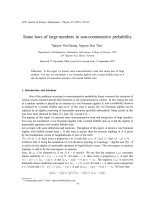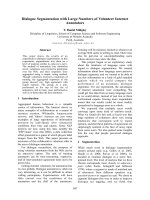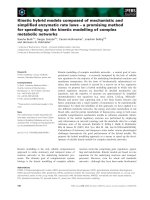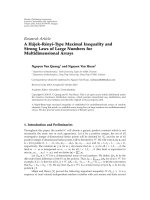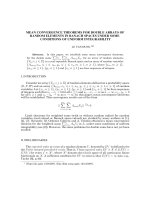SOME LAWS OF LARGE NUMBERS FOR MULTIDIMENSIONAL ARRAYS AND TRIANGULAR ARRAYS OF RANDOM SETS.
Bạn đang xem bản rút gọn của tài liệu. Xem và tải ngay bản đầy đủ của tài liệu tại đây (232.11 KB, 38 trang )
MINISTRY OF EDUCATION AND TRAINING
VINH UNIVERSITY
-------*-------
BUI NGUYEN TRAM NGOC
SOME LAWS OF LARGE NUMBERS
FOR MULTIDIMENSIONAL ARRAYS AND
TRIANGULAR ARRAYS OF RANDOM SETS
Speciality: Theory of probability and mathematical
Statistics Code: 9460106
A SUMMARY OF MATHEMATICS DOCTORAL THESIS
NGHE AN - 2022
Work is completed at Vinh University
Supervisor: 1. Prof. Dr. Nguyen Van Quang
2. Dr. Duong Xuan Giap
Reviewer 1:
Reviewer 2:
Reviewer 3:
Thesis will be defended at school-level
thesis evaluating council at Vinh
University
at ..., ..., ...
Thesis can be found at:
- Vietnam National Library
- Nguyen Thuc Hao Library and Information Center - Vinh University
1
PREFACE
1. Rationale
1.1.The limit theorems have an important role in the development of probability theory. They
have been extensively studied and applied in several fields, such as optimization and control,
stochastic and integral geometry, mathematical economics, statistics and related fields.
1.2. In the last 40 to 50 years, one of the directions in studying the limit theorems in probability theory is to extend the results for single-valued random variables to set-valued random
variables (random sets). This research can be applied in several fields such as optimization and
control, stochastic and integral geometry, mathematical economics, etc. However, since the
space of closed subsets of Banach space does not have the structure of a vector space, there are
several irregularities in the study and establishment of limit theorems. Therefore, the study of
numerical law for random sets is not only theoretical but also practical.
1.3. For multi-indexed structure, the usual partial order relation is not complete. So, if we
extend the limit theorems for random sets from the sequence case to the multidimensional array
case, then we will have a lot of news thing. This implies the results of multi-valued laws of
large numbers more interesting.
1.4.In Vietnam, the limit theorems for single-valued random variables vector space, there are
several irregularities in the study and establishment of limit theorems. For the random sets
case, in the last 10 years, some interesting results have been introduced by Nguyen Van Quang,
Duong Xuan Giap, Nguyen Tran Thuan, Hoang Thi Duyen, ... However, there are still many
other results for the single-valued random variables case that have not been extended to the
random sets case. So, there will be many interesting issues to study if we extend the results
from arrays of single-valued random variables case to arrays of random sets case.
2
With the above reasons, we have chosen the topic for the thesis as follows:
“Some laws of large numbers for multidimensional
arrays and triangular arrays of random
sets”.
2. Objective of the research
The research subjects of the thesis are to establish some laws of large numbers for multidimensional arrays and triangular arrays of random sets under different conditions.
3. Subject of the research
The research subject of the thesis is the random sets, the random upper semicontinuous
functions and some dependencies of random sets such as: pairwise independent, uniformly
integrable compact, negative dependence, negative association.
4. Scope of the research
The thesis focuses on studying the laws of large numbers for double arrays and
triangularly arrays of random sets with gap topology. Additionally, the thesis also establishes
some laws of large numbers for d-dimensional arrays of random upper semicontinuous
functions.
5. Methodology of the research
We use a combination of the fundamental methods of probability theory, convex analysis
and functional analysis such as: the convexification technique, the blocking procedure in
proving the law of large numbers.
6. Contributions of the thesis
The results of the thesis help to expand the research direction of the limit theorems for
random sets.
The thesis can be used as a reference for students, graduate students and PhD students
majoring in Theory of probability and mathematical Statistics.
7. Overview and organization of the research
3
7.1. Overview of the research
4
In this thesis, we extend the P. Ter´an’s results for double arrays of random sets and combining P. Ter´an’s method with the techniques for building a double array of selections
developed by Nguyen Van Quang and his fellows to prove the “liminf” part of Painlev´eKuratowski con- vergence. Using these results, we establish some laws of large numbers for
double arrays of random sets with the gap topology for the case m ∨ n → ∞.
For the triangular arrays of random sets, we establish some strong laws of large numbers
of rowwise independent random sets, compactly uniformly integrable and satisfying some
various conditions. To do this, we present some strong laws of large numbers for triangular
arrays of random elements and prove the “liminf” part of Painlev´e-Kuratowski convergence.
Finally, by extending the results that Nguyen Van Quang and Duong Xuan Giap introduced in
2013, we establish the strong law of large numbers for triangular arrays of random sets taking
closed- values of Rademacher type p Banach space.
Extending some results that Nguyen Tran Thuan and Nguyen Van Quang introduced in
2016 for the case multidimensional arrays, we obtain some laws of large numbers for
negatively associated and pairwise negatively dependent random upper semicontinuous
functions. To prove these limit theorems, we also introduce H´ajek-R´enyi’s type maximal
inequality for an array of negatively associated random upper semicontinuous functions and
the law of large numbers for d-dimensional arrays of pairwise negatively dependent realvalued random variables.
7.2. The organization of the research
Besides
the
sections
of
usual
notations,
preface,
general
conclusions,
and
recommendations, list of the author’s articles related to the thesis and references, the thesis is
organized into three chapters and appendix.
Chapter 1 introduces some preliminaries.
Chapter 2 presents some strong laws of large numbers for double arrays of random sets
with gap topology.
Chapter 3 establishes some strong laws of large numbers for triangular arrays of of rowwise
5
independent random sets with gap topology.
Appendix provides some maximal inequalities which form Rosenthal’s type and Ha
´jek- R´enyi’s type for multi-dimensional structure and establishes some laws of large
numbers for d-dimensional arrays of level-wise negatively associated and level-wise pairwise
negatively de- pendent random upper semicontinuous functions under various settings.
6
CHAPTER 1
PRELIMINARIES
In this chapter, we introduce some important types of convergence on the space of closed
subsets of Banach space, some preliminaries of random sets and present some basic notions
and related properties for random upper semicontinuous functions.
1.1.The convergence on the space of closed subsets of
Banach space
Suppose that t is a topology on X, {An : n ∈ Nd} is an array on the space of closed
subsets, nonempty c(X) of X. We put
t- lim inf An = {x ∈ X : x = tlim
xn, xn ∈ An, n ∈ Nd},
t- lim sup An = {x ∈ X : x = tlim
xk, xk ∈
Ank
|n|→∞
|n|→∞
|k|→∞
|n|→∞
, k ∈ Nd},
where {Ank : k ∈ Nd} is a sub-array of {A : n ∈ Nd}. The sets t- lim inf A and t- lim sup A
n
n
n
|n|→∞
|n|→∞
d
are lower limit and upper limit of the array {An : n ∈ N }, relative to topology t as |n| → ∞.
Definition 1.1.6.
Let A ∈ c(X). The array {An : n ∈ Nd} ⊂ c(X) is said to be
(1) converges in the sense of Mosco to A as |n| → ∞ and is denoted by
An
(M)
−→ A as
|n| → ∞ or (M)- lim An = A, if w- lim sup An = s- lim inf An = A.
| n|→∞
|n|→∞
|n|→∞
(2) converges in the sense of Painlev´e - Kuratowski to A with respect to the strong
topology
s of X as |n| → ∞ and is denoted by An
s- lim sup An = s- lim inf An =
A.
7
(K)
−→ A as |n| → ∞ or (K)- lim
|n|→∞
|n|→∞
|
An = A, if
n|→∞
(W)
(3) converges in the sense of Wijsman to A as |n| → ∞ and is denoted by An − → A
as
|n| → ∞ or (W)- lim
| n|→∞
An = A, if lim d(x, An) = d(x, A) for every x ∈ X.
|n|→∞
A slice of a ball is the intersection of a closed ball B¯ (x, r) (where x ∈ X, r > 0) and of a
closed half space F (x∗, α) = {x ∈ X : ⟨x∗, x⟩ ≥ α} (where x∗ ∈ X∗, x∗ ̸= 0 and α ∈ R).
(S)
(4) converges in the slice topology to A khi |n| → ∞ and is denoted by An −→ A as
|n| → ∞ or (S)- lim An = A, if lim D(An, C) = D(A, C) for all nonempty slices C of balls
| n|→∞
|n|→∞
of X.
(G)
(5) converges in the gap topology to A as |n| → ∞ is denoted by An −→ A as |n| →
∞
or (G)- lim
|n|→∞
An = A, if lim D(An, C) = D(A, C) for all nonempty bounded closed convex
|n|→∞
subsets C of X.
Remark 1.1.7. (1) (K)lim
|
An = A if and only if s- lim sup An ⊂ A ⊂ s- lim inf An.
n|→∞
(M)- |lim
n|→∞
|n|→∞
|n|→∞
An = A if and only if w- lim sup An ⊂ A ⊂ s- lim inf An.
|n|→∞
|n|→∞
(2) On the space of convex compact and non-empty subsets, Wijsman convergence leads to
Painlev´e - Kuratowski convergence. On the space of convex, closed and non-empty subsets,
the types of convergence: Wijsman convergence, slice topology and gap topology are equivalent.
1.2.The random sets
In this part, we introduce the random sets and some basic notions.
Let Bc(X) be the σ-field on c(X) generated by the sets
U − := {C ∈ c(X) : C ∩ U ̸= ∅},
for all open subsets U of X. We call Bc(X) the Effrăos -field.
Definition 1.2.1. A mapping X : → c(X) is said to be F-measurable if for every B ∈ Bc(X),
X−1(B) ∈ F. The mapping F-measurable X is also called F-measurable random set. If F = A
then X is said for shortly to be random set.
Let X be a random set, we define AX = {X−1(B), B ∈ Bc(X)}. Then AX is the smallest
sub σ-field of A with respect to X measurable. Distribution of X is a probability measure PX
on Bc(X) defined by
.
Σ
PX (B) = P X −1 (B) , B ∈ Bc(X) .
Definition 1.2.2. A family of random sets {Xi, i ∈ I} is said to be independent
(respectively, pairwise independent ) if {AXi , i ∈ I} are independentl (respectively,
pairwise independent), and is said to be identically distributed if all PXi , i ∈ I are
identical.
Definition 1.2.3. A random element f : Ω → X is called a selection of the random set X if
f (ω) ∈ X(ω) a.s.
For 1 ≤ p < ∞, Lp(Ω, A, P, X) = Lp(X) denotes the space of A-measurable functions
f : Ω → X such that the norm ∥f
∥p
= (E∥f
∥p
1
) p is finite. If F = A then Lp(F, X) is denoted
for shortly by Lp(X). If X = R then Lp replace Lp(R).
For each random set F-measurable X and for p ≥ 1, we denote Sp X
(F) = {f ∈ Lp(F, X) :
f (ω) ∈ X(ω) a.s.}. In the case F = A then SXp (A) is replaced by SXp .
Definition 1.2.4.
integrable if S1
The random set X : Ω → c(X) is called
Definition 1.2.5.
defined
The expectation of integrable random set X, denoted by EX, is
X
is nonempty.
by
EX := {Ef : f ∈ SX1 }
where Ef is the usual Bochner integral of random element f .
In Definition 1.1.6, if we replace An by Xn(ω) and replace A by X(ω) for ω in a set with
probability 1, where X, Xn, n ∈ Nd are random sets, then we obtain the definition of almost
sure convergence for random sets.
1.3.The uniformly integrable compactness and the uniformly
bounded of an array of random sets
We present some notions: compactly uniformly integrable, compactly uniformly integrable
in the Ces`aro sense, uniformly bounded for double array and triangular array of random ele-
ments and random sets.
Definition 1.3.1.
be
(1) A double array of random elements {fmn : m ≥ 1, n ≥ 1} is said to
uniformly integrable in the Ces`aro sense if
Σ
.
−1
lim sup (mn)
Σ
m
En
∥fij
∥1(∥f
(.)∥>x)
Σ
= 0.
ij
x→∞ m,n≥1
i=1 j=1
(2) A double array of random elements {fmn : m ≥ 1, n ≥ 1} is said to be compactly
uniformly integrable in the Ces`aro sense if for every ε > 0, there exists a compact subset
K of
X such that
sup (mn)
−1
m,n≥
1
(.)∈/K)
m Σ
n
.
Σ
i=1 j=1
E ∥fij ∥1(fi Σ
< ε.
j
In general, compactly uniform integrability in the Ces`aro sense is stronger than the
uniform integrability in the Ces`aro sense, but they are equivalent in the real or the identically
distributed case.
Let A be a subset of Ω, the complement of the set A with respect to Ω is denoted by Ac.
(3) A double array of random sets {Xmn : m ≥ 1, n ≥ 1} is said to be compactly uniformly
integrable in the Ces`aro sense if for every ε > 0, there exists a compact subset K of
X such
that
sup (mn)
−1
m,n≥
1
Definition 1.3.2.
m n
Σ
Σ .
i=1 j=1
Σ
E ∥Xij ∥1(Xi
(.)⊂K)c
< ε.
j
(1) A triangular array of random elements {fni : n ≥ 1, 1 ≤ i ≤ n} is
said to be compactly uniformly integrable if for every ε > 0, there exists a compact subset
K of X
such that
.
Σ
sup E ∥fni ∥1(fni (.)∈/K) < ε.
n,
i
(2) A triangular array of random sets {Xni : n ≥ 1, 1 ≤ i ≤ n} is said to be compactly
uniformly integrable if for every ε > 0, there exists a compact subset K of X such that
.
sup E ∥Xni ∥1(Xni (.)⊂K)c
n,
i
Σ
< ε.
Definition 1.3.3. (1) A triangular array of random elements {fni : n ≥ 1, 1 ≤ i ≤ n} is
uniformly bounded by a random variable ξ if for all n ≥ 1, 1 ≤ i ≤ n and for every real number
t > 0,
P (∥fni∥ > t) ≤ P (|ξ| > t).
(2) A triangular array of random sets {Xni : n ≥ 1, 1 ≤ i ≤ n} is uniformly bounded by a
random variable ξ if for all n ≥ 1, 1 ≤ i ≤ n and for every real number t > 0,
P (∥Xni∥ > t) ≤ P (|ξ| > t).
1.4.The random upper semicontinuous functions
In this section, we sum up some basic notions and related properties for random upper
semicontinuous functions.
Let K be the set of compact intervals of R. If x is an element of K, then it will be denoted
by x = [x(1); x(2)], where x(1), x(2) are two end points. The Hausdorff distance dH on K is defined
by
dH (x, y) = max{|x(1) − y(1)|; |x(2) − y(2)|}, x, y ∈ K.
For a function u : R → [0; 1], the α-level set of u is defined by [u]α = {x ∈ R : u(x) ≥ α}
for each α ∈ (0; 1]. For each α ∈ [0; 1), [u]α+ denotes the closure of {x ∈ R : u(x) >
α}. In particular, [u]0+ is called the support of u and denoted by supp u. The level set [u]α of
u is closed for all α ∈ (0; 1] iff u is upper semicontinuous function. A upper semicontinuous
function u : R → [0; 1] is called quasiconcave function if u(λx + (1 − λ)y) ≥ min{u(x),
u(y)} for all x, y ∈ R, and its equivalent condition is that [u]α is a convex subset of R for
every α ∈ (0; 1]. Let U denote the family of all upper semicontinuous functions u : R → [0; 1]
satisfying the following conditions
(1) supp u is compact;
(2) [u]1 ̸= ∅;
(3) u is quasiconcave.
Therefore, if u ∈ U then for each α ∈ (0; 1], [u]α is an interval of R and denoted
Σ
Σ
(1)
by [u]α = α[u] ;α[u]
(2)
, whereα[u](1) and α[u](2) are two end points of the interval.
Definition 1.4.2. A mapping X : Ω → K is called a K-valued random variable if X−1(B) ∈
A
for all B ∈ B(K), where B(K) is the Borel σ-algebra on (K, dH ).
Definition 1.4.3. A mapping X : Ω → U is called a U-valued random variable (or fuzzy
random variable, or random upper semicontinuous function) if [X]α is a K-valued
random variable for all α ∈ (0; 1].
The following is the concepts of negative dependence and negative association for the case
multidimensional.
Definition 1.4.9. (1) A finite family {Xi, 1 ≤ i ≤ n} of real-valued random variables is
said to be negatively associated if for any disjoint subsets A1, A2 of {1, 2, ..., n} and
any real coordinatewise nondecreasing functions f on R|A1 | , g on R|A2 | such that
Σ
Σ
Cov f1 (Xi , i ∈ A1 ), f2 (Xj , j ∈ A2 ) ≤ 0,
whenever the covariance exists, where |A| denotes the cardinality of A.
An infinite collection of real-valued random variables is negatively associated if every finite
subfamily is negatively associated.
(2) Let {Xn, n ∈ Nd} be an array of K-valued random variables. Then, {Xn, n ∈ Nd} is
said to be negatively associated nif {X(1), n ∈ Nd}nand {X(2), n ∈ Nd} are arrays of
negatively associated real-valued random variables.
(3) Let {Xn, n ∈ Nd} be an array of U-valued random variables. Then {Xn, n ∈ Nd} is
said to be level-wise negatively associated if {[Xn]α, n ∈ Nd} are arrays of negatively
associated K-valued random variables for all α ∈ (0; 1].
Definition 1.4.10. (1) A finite family {Xi, 1 ≤ i ≤ n} of real-valued random variables is
said to be negatively dependent if the two following inequalities hold
n
Y
P(X1 > x1, ..., Xn > xn) ≤ P(Xi > xi),
i=1
n
Y
P(X1 ≤ x1, ..., Xn ≤ xn) ≤
P(Xi ≤ xi),
i=1
for all xi ∈ R, i = 1, 2, ..., n.
An infinite collection of real-valued random variables is negatively dependent if every
finite subfamily is negatively dependent.
A family {Xi, i ∈ I} of real-valued random variables is pairwise negatively
dependent if P(Xi > x, Xj > y) ≤ P(Xi > x)P(Xj > y) (or equivalently, P(Xi ≤ x, Xj ≤
y) ≤ P(Xi ≤ x)P(Xj ≤ y)) for all i ̸= j and all x, y ∈ R.
(2) Let {Xn, n ∈ Nd} be an array of K-valued random variables. Then, {Xn, n ∈ Nd}
is said to be negatively dependent (resp. pairwise negatively dependentn ) if {X(1), n
∈ Nd} nand {X(2), n ∈ Nd} are arrays of negatively dependent (resp. pairwise negatively
dependent) real-valued random variables.
(3) Let {Xn, n ∈ Nd} be an array of U-valued random variables. Then {Xn, n ∈
Nd} is said to be level-wise negatively dependent (resp. level-wise pairwise negatively
dependent ) if {[Xn]α, n ∈ Nd} are arrays of negatively dependent (resp. pairwise negatively
dependent) K-valued random variables for all α ∈ (0; 1].
The conclusions of Chapter 1
In this chapter, we obtain some main results:
- Introduce some important convergences on the space of closed subsets of Banach space;
- Present random sets and some and some related concepts;
- Present some basic notions and related properties for random upper semicontinuous
functions.
CHAPTER 2
SOME STRONG LAWS OF LARGE NUMBERS
FOR DOUBLE ARRAYS OF RANDOM SETS
WITH GAP TOPOLOGY
In this chapter, we establish some strong laws of large numbers for a double array of independent (or pairwise independent) random sets with the gap topology under various settings.
2.1.The strong laws of large numbers for a double array of
compactly uniformly integrable in the Ces`aro sense
random sets
In this section, we introduce and prove a strong laws of large numbers for a double array of
pairwise independent, compactly uniformly integrable in the Ces`aro sense random sets.
At first, we give some lemmas which will be used later.
Lemma 2.1.1. Assume that {Fmn : m ≥ 1, n ≥ 1} is a double array of compactly
uniformly integrable in the Ces`aro sense random sets. Then
(1) {fmn : m ≥ 1, n ≥ 1} is a double array of compactly uniformly integrable in the
Ces`aro
sense random elements, where fmn F∈mnS0
, for all m ≥ 1, n ≥ 1.
(2) {s(x∗ , Fmn ) : m ≥ 1, n ≥ 1} is a double array of uniformly integrable in the
Ces`aro sense random variables, for every x∗ ∈ S∗.
Lemma 2.1.2. Let A be a subset of X, B be the closed unit ball of a fixed
arbitrary equivalent norm of X and let r > 0. If A is a compact set then
coA + r.B = co(A + r.B).
(2.1)
The theorem below will establish the strong laws of large numbers for a double array of
pairwise independent, compactly uniformly integrable in the Ces`aro sense random sets with
respect to the gap topology based on Ter´an’s method and C.Castaing, N.V. Quang, D.X. Giap’s
technique.
Theorem 2.1.5. Let 1 ≤ p ≤ 2 and {Xmn : m ≥ 1, n ≥ 1} be a double array of
pairwise independent, compactly uniformly integrable in the Ces`aro sense random sets
and satisfying the following conditions:
(1)
∞
Σ Σ
p
EX
∥ mn
∞
(mn)p
< ∞,
m=1 n=1
(2) there exists X ∈ k(X) such that
X ⊂ s- lim inf (clE(Xmn, A X mn )),
(2.2)
lim sup s(x∗, clEXmn) ≤ s(x∗, X), x∗ X∗.
(2.3)
m∨n→∞
m∨n→∞
Then
m
Σ
1 cl Σ
mn
n
Xij (ω) → coX
i=1 j=1
almost surely, in the gap topology, as m ∨ n → ∞.
2.2.The strong laws of large numbers for a double array of
indepen- dent closed valued random variables in a
separable Banach space
In this section, we establish some strong laws of large numbers for double arrays of independent, pairwise independent closed valued random variables in a separable Banach space.
At first, we introduce the strong laws of large numbers for a double array of random sets
in a Rademacher type p Banach space.
Theorem 2.2.2.
where 1 ≤ p ≤ 2. Let
Suppose that X is a Rademacher type p Banach space,
{Xmn : m ≥ 1, n ≥ 1} be a double array of independent random sets satisfying the
following conditions:
(1)
∞
p
Σ Σ
EX
∥ mn
∞
(mn)p
< ∞,
m=1 n=1
(2) there exists X ∈ k(X) such that the conditions (2.2) and (2.3) are satisfied.
Then
1
m
n
Σ
cl
Σ
X (ω) → coX
ij
mn i=1 j=1
almost surely, in the gap topology, as m ∨ n → ∞.
The following theorem will establish the strong laws of large numbers for a double array
of pairwise independent identically distributed random sets with respect to the gap topology.
Theorem 2.2.4. Suppose that {Fmn : m ≥ 1, n ≥ 1} is a double array of pairwise
independent random sets, having the same distribution as X which is a k(X)-valued
random set satisfying E(∥X∥ log+ ∥X∥) < ∞. Then,
m
1 Σ
n
Σ
mni=1 j=1
F ij (ω) → coEX
almost surely, in the gap topology, as m ∨ n → ∞.
The conclusions of Chapter 2
In this chapter, we obtain some main results:
- Establish some strong laws of large numbers for double arrays of random sets in the
cases: pairewise independent and compactly uniformly integrable in the Ces`aro sense, or
pairewise independent identically distributed.
- Prove the strong laws of large numbers for double arrays of independent random sets in
a Rademacher type p Banach space.
CHAPTER 3
SOME STRONG LAWS OF LARGE NUMBERS
FOR TRIANGULAR ARRAYS OF RANDOM
SETS WITH GAP TOPOLOGY
In this chapter, at first, we prove some strong laws of large numbers of triangular arrays
of random elements. Next we establish some strong laws of large numbers of triangular arrays
of random sets with respect to the gap topology.
3.1.The strong laws of large numbers of triangular arrays of
random elements
In this section, we will establish some strong laws of large numbers of triangular arrays of
random elements under various settings. This results will be used to prove some strong laws of
large numbers for triangular arrays of random sets.
Theorem 3.1.1. Let {fni : n ≥ 1, 1 ≤ i ≤ n} be a triangular array of rowwise
independent and compactly uniformly integrable random elements in a separable
Banach space. Let ψ(t) be a positive, even, convex, continuous function such that
ψ(|t|)
|t|r
↑ and
ψ(|t|)
↓ as |t| ↑ ∞,
(3.1)
|t|r+1
for some nonnegative integer r and there exists a positive constant C 1 with
ψ(a + b) ≤ C1(ψ(a) + ψ(b)) for all real numbers a, b.
Then the following conditions
∞
n
Σ ΣE(ψ(∥fni∥))
n=1 i=1
∞
ψ(n)
<
;
(3.2)
. Σn
Σ∞
n=1
f
i=1
E
2Σ2.k
< ∞,
ni
n
for some positive integer k, imply
that
n
1
n
Σ i=
(fni − Efni) → 0 a.s. as n → ∞.
1
Theorem 3.1.4. Let {fni, n ≥ 1, 1 ≤ i ≤ n} be a triangular array of rowwise
independent and compactly uniformly integrable random elements in a separable
Banach space. If {fni} are uniformly bounded by a random variable f with Ef
2
<
∞, then for all ε > 0
∞
. 1 Σn
Σ
(fni − Efni) > ε
P
n=1
n
Σ
i=
1
<
∞.
3.2.The strong laws of large numbers of triangular arrays of
random sets
In this section, the first two theorems will establish some strong laws of large numbers for
triangular arrays of rowwise independent and compactly uniformly integrable random sets with
respect to the gap topology.
Theorem 3.2.2. Let {Xni : n ≥ 1, 1 ≤ i ≤ n} be a triangular array of rowwise
independent and compactly uniformly integrable random sets in a separable Banach
space. Let ψ(t) be a pos- itive, even, convex, continuous function and ψ(t) satisfies
(3.1) and (3.2) for some nonnegative integer r. If the following conditions are
satisfied
∞
Σ
Σ
.
n
n=1 i=1
.
Σ ∞ Σn
Σ
E ψ(∥Xni∥)
ψ(n) ∞<
Xni
E
n
;
Σ2.k
2
<
∞,
ᄃ i=
n=1
1
for some positive integer k and there exists X ∈ k(X) such that
X ⊂ s- lim inf(clE(Xni|AXni ));
n→∞
≤
(3.11)
lim sup s(x∗, clEFni) s(x∗, X) for all x∗ X∗,
n→∞
(3.12)
the
n
1
cl
n
Σ
F (ω) → coX
n
ni
i=1
almost surely, in the gap topology, as n → ∞.
Theorem 3.2.4. Let {Xni : n ≥ 1, 1 ≤ i ≤ n} be a triangular array of rowwise
independent and compactly uniformly integrable random sets in a separable
Banach space. If {∥Xni∥ : n ≥ 1, 1 ≤ i ≤ n} are uniformly bounded by a random
variable ξ with Eξ 2 < ∞ and there exists X ∈ k(X) satisfying (3.11) and (3.12),
then
1
cl
n
Σ
F (ω) → coX
n
ni
i=1
almost surely, in the gap topology, as n → ∞.
The theorem below will establish the strong laws of large numbers for a triangular
array of rowwise independent random sets in a separable Banach space of type p (1 < p ≤
2) with respect to the gap topology, based on Ter´an’s method and the results of Quang
and Giap in 2013.
Theorem 3.2.5.
Let {Xni : n ≥ 1, 1 ≤ i ≤ n} be a triangular array of rowwise
independent, bounded expectation random sets in a separable Banach space of
type p (1 < p ≤ 2). Let {an}
be a sequence of positive real numbers such that an+1 > an
and lim
an = +∞. Let ψ(t) be a
n→∞
positive, even, convex, continuous function such that
ψ(|t|)
|t|r
of |t| ,
ψ(|t|)
|t|r+p−1
is a monotone increasing
function
is a monotone decreasing function of |t| for some nonnegative integer r
and there
exists a positive constant C1 so that ψ(t) satisfying (3.2). If the following conditions
are satisfied
Σ Σ
∞ n
.
E ψ(∥F
n=1
i=1
∥)
ni Σ
ψ(n)
<
∞;
.
Σ
Σn
n=1
F
Σp.k
p
